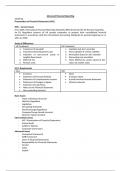Lecture notes
Advanced Financial Reporting: Accounting and Finance
- Module
- Advanced Financial Reporting
- Institution
- University Of East London (UEL)
Presentation of Financial Statements (IAS1) Financial Performance Analysis Financial Statement Analysis Ratio Bank Business Combinations Consolidated Group Statements and Associates Cash Flow Statements Deferred Taxation Impairment Provisions and Contingencies (IAS 37) Leases and Off-Balan...
[Show more]



